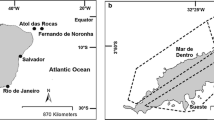Abstract
Ozark cavefish, Amblyopsis rosae, is a threatened species endemic to the Springfield Plateau of the Ozark Highlands in Arkansas, Missouri, and Oklahoma. One of the largest known Ozark cavefish populations, located in Logan Cave, Arkansas, was surveyed 25 times over a two-year period between 1993 and 1995. During the study, 147 Ozark cavefish > 30 mm (TL) were marked with visual implant tags and 140 Ozark cavefish were available for recapture; 68 were recaptured 189 times and the rest (72) were never recaptured. Individual Ozark cavefish persisted in Logan Cave for a relatively short time. Only 14% of 80 fish tagged during a previous study in 1992 were recaptured during this study, and half of all recaptured fish disappeared within three months. However, if a fish persisted for at least seven months in the cave, its probability of being recaptured over an additional year was high. Maximum persistence of a tagged fish was 28 months, suggesting these fish have a maximum life-span of 4–5 years. Growth averaged 0.6 mm per month, with maximum recorded growth of 6 mm per month and a maximum size of 65 mm TL. Smaller fish grew faster than larger fish but growth rates were sporadic, with several mid-sized fish (45–49 mm) showing little growth (0–3 mm year-1) while some fish > 50 mm grew up to 12 mm year-1. Most fish gained in length during April–October, the same period a maternity colony of gray bats occupied the cave. Gross Ozark cavefish movement over the study period ranged up to 1002 m, with a mean movement of 1.2 m day-1; movement was positively correlated with Ozark cavefish total length. Death seemed the most likely explanation for loss of tagged Ozark cavefish, including fish that emigrated out of the cave. Little up-stream movement was recorded between reaches and did not account for loss of tagged fish. Reproduction within the cave and immigration from the aquifer accounted for persistence of Ozark cavefish in Logan Cave.
Similar content being viewed by others
References
Bond, C.E. 1996. Biology of fishes. Harcort Brace, New York. 750 pp.
Boyd, G.L. 1997. Metabolic rates and life history of aquatic organisms inhabiting Logan Cave stream in Northwest Arkansas. MS Thesis, University of Arkansas, Fayetteville. 98 pp.
Brown, J.Z. 1996. Population dynamicsand growth of Ozark cavefish in Logan Cave National Wildlife Refuge, Benton County, Arkansas. MS Thesis, University of Arkansas, Fayetteville. 105 pp.
Eigenmann, C.H. 1898. A new blind fish. Proc. IndianaAcad. Sci. 1897: 231.
Guy, C.S., H.L. Blakenship & L.A. Nielsen. 1996. Tagging and markingpp. 353–383. In: B.R. Murphy & D.W. Willis (ed.) Fisheries Techniques, Amer. Fish. Soc., Bethesda.
Harvey, M.J. 1992. Bats of the eastern United States. Tennessee Tech. Univ., Cookeville. 22 pp.
Haw, F.,P.K. Bergman, R.D. Fralick, R.M. Buckley & H.L. Blankenship. 1990. Visible implant fish tag. pp. 311–316. In: N.C. Parker et al. (ed.) Fish-Marking Techniques, Amer. Fish. Soc. Symp. 7, Bethesda.
Jegla, T.C. & T.L. Poulson. 1970. Circadian rhythms, I: reproduction in cave crayfish Orconectes pellucidus intermis. Comp. Biochem. Physiol. 33: 347–355.
Johnson, J.E. 1987. Protected fishes of the United States andCanada. Amer. Fish. Soc., Bethesda. 42 pp.
Means, M.L. 1993. Population dynamics and movement of Ozarkcavefish in Logan Cave NWR, Benton County, Arkansas, with additional baseline water quality information. MS Thesis, University of Arkansas, Fayetteville. 126 pp.
Means, M.L. & J.E. Johnson. 1995. Movement ofthreatened Ozark cavefish in Logan Cave National Wildlife Refuge, Arkansas. Southwest. Nat. 40: 308–313.
Pflieger, W.L. 1997. The fishes of Missouri. Missouri Cons. Comm., Jefferson City. 371 pp.
Pollock, K.H., J.D. Nichols, C. Brownie & J.E. Hines. 1990. Statistical inference for catch-recapture experiments. Wildlife Monog. (107): 1–97.
Poulson, T.L. 1963. Cave adaptation in amblyopsidfishes. Amer. Midl. Nat. 70: 257–290.
Robison, H.W. & T.M. Buchanan. 1988. Fishes ofArkansas. Univ. of Arkansas Press, Fayetteville. 536 pp.
Robins, C.R., R.M. Bailey, C.E. Bond, J.R. Booker, E.A. Lachner, R.N. Lea & W. B. Scott. 1991. Common and scientific names of fishes from the United States and Canada. Amer. Fish. Soc. Special Publ. (20): 1–182.
Willis, L.D. & A.V. Brown. 1985.Distribution and habitat requirements of the Ozark cavefish, (Amblyopsis rosae). Amer. Midl. Nat. 114: 311–317.
Woods, L.P. & R.F. Inger. 1957. The cave, spring, and swamp fishes of the family Amblyopsidae of thecentral and eastern United States. Amer. Midl. Nat. 58: 232–256.
Zar, J.H. 1984. Biostatisticalanalysis. Prentice Hall, Englewood Cliffs. 718 pp.
Author information
Authors and Affiliations
Rights and permissions
About this article
Cite this article
Brown, J.Z., Johnson, J.E. Population Biology and Growth of Ozark Cavefish in Logan Cave National Wildlife Refuge, Arkansas. Environmental Biology of Fishes 62, 161–169 (2001). https://doi.org/10.1023/A:1011860821932
Issue Date:
DOI: https://doi.org/10.1023/A:1011860821932




